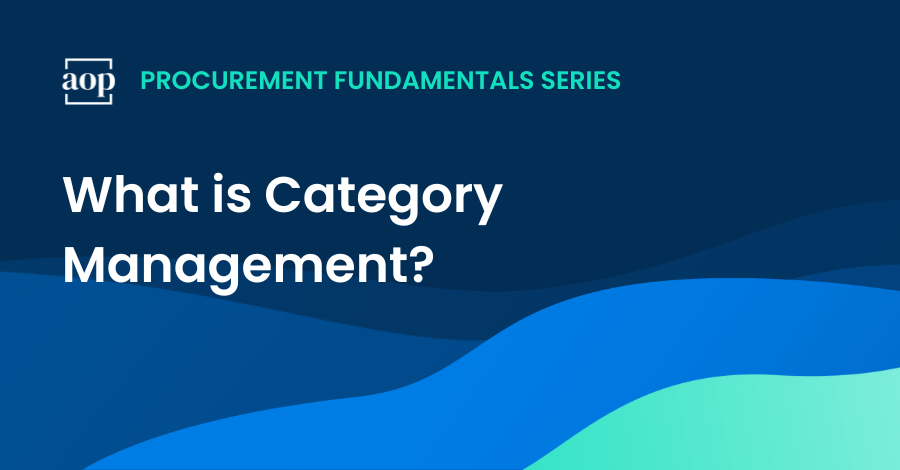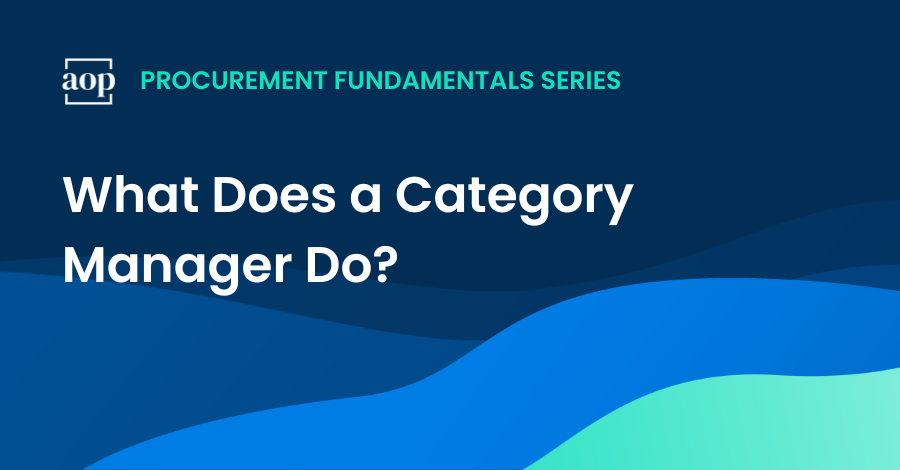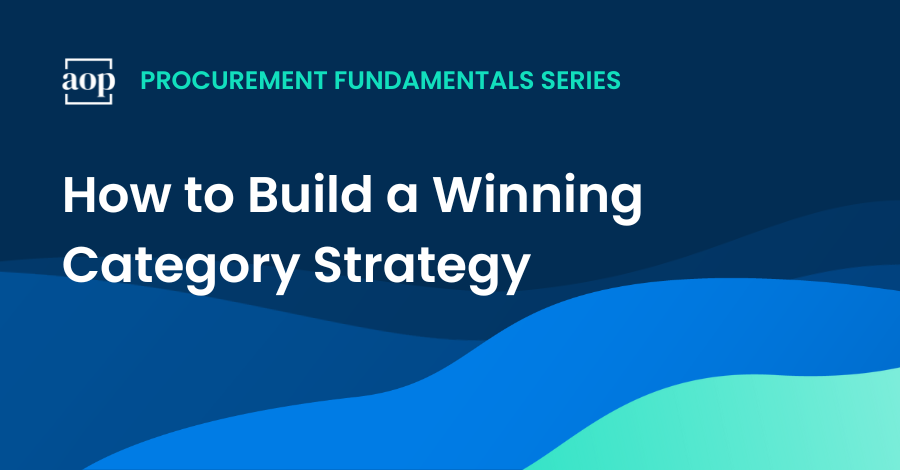
Category management in procurement is a bit like pickles in your sandwich. Some people think it’s outdated. Many experts think it’s misunderstood. Even if you didn’t like it the first time, it’s worth trying again.
When implemented well, category management establishes a common language and clear strategy that reach beyond your procurement organization. It can bring sustained value across the value chain while reducing supply risk.
To give you a deeper understanding of category management and its benefits, we reflect on the insights shared by Lynn Rideout, Senior Manager of Category Management, and Chris Eyerman, Senior Director of Program Management from Denali Sourcing Group in episode 96 of the Art of Procurement podcast. Lynn and Chris have over 30 years of combined experience leading change management and category strategies in business.
We’ll summarize the experts’ view of what you need to know. First, let’s go through some category management foundations.
What is category management in procurement?
Category management is a strategic approach to procurement where similar products or services are grouped together in order to enhance efficiency and improve supplier relationships.
Lynn Rideout defines it as ensuring that “all of the tasks and various pieces that we do in procurement… are really approaching it from aligning to the company’s vision and the company’s business objectives.” This alignment requires a deep understanding of the market and leveraging procurement expertise to plan long-range value for the company.
Is category management a tool, methodology or mindset?
Category management goes beyond a traditional procurement focus by adopting a methodology and mindset that prioritize strategic capabilities. It’s not just a tool but an encompassing approach that involves methodologies, knowledge, tools, and processes. As Rideout elaborates, it’s about having the “right methodology and mindset… understanding what category management means and all of the pieces it’s going to touch.”

This strategic approach challenges procurement professionals to think beyond immediate procurement tasks and consider how their work impacts and is aligned with broader business goals. It’s a shift from operational to strategic thinking, from isolated procurement activities to integrated business planning and execution.
Six building blocks of category management
Every procurement organization will have their own way of adopting category management. In that regard, there is no one true blueprint to follow. Usually, it is necessary to develop foundations that look at the opportunity from a number of different strategic considerations.
Effective category management draws its value from these six pillars or building blocks:
- Strategic framework(s)
- Alignment towards business goals
- Active stakeholder management
- Process and methodology
- Governance and strategic direction
- Relevant skills and competencies
1. Strategic framework for category management
Companies often adopt category management with the goal of moving towards a more strategic, holistic approach to procurement. It combines a comprehensive assessment of internal needs and an external market analysis to craft a strategic plan that aligns procurement activities with business objectives. A category management framework can be useful to show that procurement not only contributes to cost savings but also supports business innovation, sustainability, and growth.
Chris Eyerman emphasizes the necessity of a robust process that guides category managers across various maturity levels, challenging them to think broadly about their categories. He mentions that category management should be seen as “a fundamental shift to the way organizations do procurement,” highlighting the need for a common language and consistent application across the organization.
2. Alignment with business goals
The transition to category management requires more than just adopting a new category management process; it requires a mindset shift within the procurement function and across the organization. Category management must be embedded into the DNA of the procurement organization, influencing how procurement leaders and professionals think, plan, and execute their responsibilities.
Both Rideout and Eyerman stress the importance of aligning category management with the company’s strategic goals and engaging stakeholders throughout the process. The success of category management hinges on its integration into business planning processes, ensuring that procurement strategies are developed in collaboration with business stakeholders and aligned with overall business objectives.
3. The importance of stakeholder engagement
A critical component of successful category management is effective stakeholder engagement. Category management strategies should not be developed in isolation but in close collaboration with stakeholders across the organization. This collaborative approach ensures that procurement strategies are relevant, aligned with business needs, and capable of delivering real value to the organization.
Engaging stakeholders in the category management process also helps in breaking down silos, fostering a culture of collaboration, and ensuring that procurement is seen as a strategic partner rather than just a support function. As Eyerman points out, the involvement of stakeholders and executives is essential for embedding category management within the organization and making it a sustainable part of the procurement function.
4. Process and methodology
At the heart of category management lies a comprehensive process that guides the procurement team through developing and executing category strategies. This process, as Chris Eyerman describes it, includes a mix of internal assessments, stakeholder mapping, and external market analysis. It’s about synthesizing strategic options and developing a vision and strategy that align with the organization’s goals. This methodological approach ensures that procurement is not merely transactional but strategically driven, aiming for long-term value rather than short-term gains.
5. Governance and strategic direction
For category management to be effective, it must be governed by a clear vision and a strategic direction. This involves setting up governance structures like category councils, which integrate business stakeholders into the procurement process, ensuring alignment with business needs and strategic objectives.
As Eyerman highlights, “good governance” and a clear category roadmap are crucial for driving accountability and making category management a sustainable practice within the organization. It’s about moving from a vision of delivering world-class category management to defining what that means in actionable, measurable terms.
6. Category manager competency and development
The transition to category management demands a shift in skills and competencies for procurement professionals. Category managers must be adept at strategic planning, analytics, stakeholder relationship management, and possess the ability to ‘sell’ the category strategy to various stakeholders within the organization.
Continuous training, coaching, and targeted skills development are important for building these competencies. As Eyerman points out, treating category management as a discipline and focusing on the continuous development of category managers are vital for the success of the category management program.
How to follow your category management roadmap
Implementing category management is a journey that begins with selecting the right categories to focus on and gradually expanding the scope and depth of the program. It involves starting with categories that are critical to the business and using the successes in these areas to build momentum and credibility for the category management approach.
Prioritize categories
Not all categories are created equal. Some have a more significant impact on the business’s strategic objectives than others. It’s essential to prioritize categories based on their strategic importance, potential for value creation, and alignment with business goals. This prioritization helps in focusing efforts and resources on areas that will yield the most significant benefits.
Stakeholder engagement and collaboration
Engaging stakeholders from the outset is critical to the successful implementation of category management. Healthy collaboration ensures that category strategies are not only aligned with business objectives but also have the buy-in and support necessary for successful execution. Building strong relationships with stakeholders allows category managers to gain insights into the business’s needs and tailor their strategies accordingly.
Focus on continuous improvement
The true challenge of category management lies not in its implementation but in sustaining and continuously improving it over time. As Lynn Rideout aptly notes, category management is a journey that “never ends,” requiring ongoing efforts to embed it deeply within the organization’s fabric.
Adjust to business and market needs
As the business environment and market dynamics change, category strategies must also evolve. This requires a continuous improvement mindset, where category managers are always looking for opportunities to optimize and enhance the value delivered. It involves regular reviews of category strategies, stakeholder needs assessments, and market analysis to ensure that procurement remains aligned with the business’s evolving needs.
Scale up and standardize
For organizations operating on a global scale, the ability to adopt category management practices and integrate them across different regions and business units is crucial. This means moving beyond local or regional strategies to develop and implement global category strategies where applicable, leveraging the organization’s full purchasing power and driving consistency in procurement practices across the globe.
Key takeaways on the role of category management in procurement
Category management represents a strategic shift from traditional procurement practices, focusing on aligning procurement activities with business goals and leveraging market insights for long-term value creation.
The insights shared by Lynn Rideout and Chris Eyerman make clearthat successful category management requires a comprehensive approach, encompassing robust processes, clear governance, competency development, and a commitment to continuous improvement.
As organizations set forth on this journey, the key to success lies in embedding category management into procurement’s DNA and ensuring it is closely aligned with the business’s strategic objectives. By doing so, procurement can elevate their role within the organization, moving from a support function to a strategic partner capable of driving significant business value.
For more tips, visit our Category Management Best Practices Hub.
Hear more expert views on category management
Deepen your understanding of category management through these expert interviews on the Art of Procurement podcast:
- Advanced Category Management: Organizational Building Blocks with Lynn Rideout and Chris Eyerman
- The Differentiators of Category Management Leaders & Followers with Mark Webb
- How to Engage with Skeptical Stakeholders to Build Effective Category Strategies with Bill Michels
- Navigating the Perfect Storm Using Category Management with Stephane Morel





.png)
